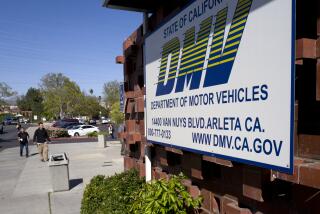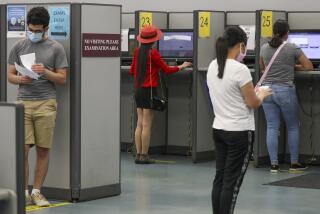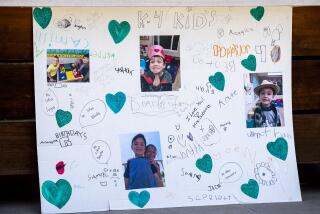Rules of the road
The streets and freeways of California are rife with a particular species: The “traffic expert.” These people are not researchers at UCLA or analysts at Caltrans, but normal drivers who, possessed with the small diploma known as a driver’s license, tend to consider themselves sage observers of all that goes on through the windshield. They’ll tell you they know the “cures” for congestion, who the “best” and “worst” drivers are and which traffic laws don’t happen to apply to them (e.g., cellphones should be prohibited, but only when used by other drivers).
But given that most of us have about as much knowledge of the actual traffic code as we do of the laws of algebra (which we also last studied when we were teens), and given that humans are prone to gaps in their perceptual systems and a dizzying array of cognitive biases in their decision-making processes, and given that traffic is a large, fast and dynamic system, of which we can only observe a small part at any one time, we should take the self-styled traffic experts with a bit of amber-tinted caution.
Even though it’s true that the average American in 2005 spent 38 hours annually stuck in traffic, we don’t know nearly as much as we think we do. Try to picture, for instance, the white stripes that divide the lanes on a major highway. How long would you guess they are? How much space would you say lies between each stripe? When I was asked this question, I guessed 5 feet, with maybe 15 feet between. But in fact, while the exact length varies, the U.S. standard calls for 10 feet, though depending on the speed limit of the road, the stripes might be as long as 12 to 14 feet. Seen from above, in most cases, it is clear that the stripe is as long as the cars themselves. Their ratio to the space between them is generally 3 to 1 -- meaning that for a 10-foot stripe, there’s 30 feet of space.
Maybe you guessed better than I did. But in case you didn’t, assembled below are a few things about the road that you may not have learned in driving school (or perhaps you’ve forgotten).
Fast highways are not necessarily more efficient highways. Given a choice, most L.A. drivers rushing home on the freeway would rather go 80 mph than 60 mph. It gets you there sooner, right? Yes ... but as so often happens in traffic, what’s best for the individual is not always best for the system: According to repeated studies, the highway as a whole handles more vehicles per hour at the slower speed than at the faster. The reason has to do with the larger “headways,” or gaps between vehicles, which grow disproportionately with higher speeds. Most people are extremely surprised to learn that even at its most efficient usage rate, only an estimated 5.5% of the road surface is actually being occupied by vehicles at any one time.
Where all the drivers are above-average. Under what psychologists call “optimistic bias,” or the “Lake Wobegon effect,” the freeways of California -- and everywhere else -- are subject to a mathematical peculiarity: A majority of drivers think they are more skilled than the average. A majority say they are better drivers, less likely to be involved in a crash than other drivers. (Passengers, by the way, aren’t nearly as confident that they will avoid an accident as drivers are.) Interestingly, one study found that men are less likely than women to believe that risky driving will lead to a crash -- although men, of course, are far more likely to be involved in serious crashes than women.
Another problem with tailgating. You may think that the main danger of tailgating is that a driver might not be able to stop in time if the vehicle ahead of him brakes suddenly. But we often forget about the effects of tailgating on the drivers behind us. When Gary A. Davis, a researcher at the University of Minnesota, analyzed a “platoon” of seven cars in which the seventh had crashed into the sixth as the whole platoon had come to a sudden stop, he found that although all the cars had been “over-driving” their potential reaction time (i.e., tailgating), it was actually the third car in the platoon that arguably bore a substantial portion of responsibility for the crash. The third car “consumed” more braking distance than the others, which means that driver took longer to react to the brake lights ahead of him, hence had to brake harder and thus “ate up” the available stopping time for the drivers behind him. The effect was whipsawed down the line to the point at which the last car, even though it had a faster reaction time than the third, could not physically stop in time. One lesson here is that when you tailgate, you not only give yourself less time to react, you give the car behind you less time.
Warning: “good” driver ahead. A study by Britain’s Department for Transport discovered a “perverse relationship” when looking at its records. The group that had the highest pass rate on the in-car portion of the driving test -- young males -- also went on to have the highest crash rates. Driving tests, they cautioned, measure “driver competence but not driver behavior.”
Risk is not always where or what you think it is. No one likes to drive near large trucks because they are rightly perceived as dangerous: Nearly nine out of 10 times when trucks and cars collide, it’s the truck driver who walks away alive. That’s simple physics: A truck weighs 20 to 30 times more than a car. But research by Daniel Blower at the University of Michigan has shown that in a majority of cases, it’s the car that bears the largest brunt of responsibility for the crash (i.e., it bears the greater share of what are called “contributory factors”). After examining more than 5,000 fatal truck-car crashes (and taking care not to be fooled by “survivor bias,” because the story ultimately gets told by the truck driver who survives 85% of the time), he found that in 70% of cases, the driver of the car had the sole contributing responsibility in the crash.
“Routine traffic stops” often aren’t routine. When a researcher at Britain’s Transport Research Laboratory analyzed a random sample of motorists’ driving records, and then compared the results with the number of non-motoring offenses that had been committed, he found that those drivers who had committed non-motoring offenses were much more likely to commit motoring offenses. A driver who had two arrests for car theft, for example, committed an average of 25 times more motoring offenses as someone who hadn’t been convicted of vehicle theft. A driver who had been convicted of other kinds of theft committed an average of 10 times more motoring offenses.
The trouble with warning signs. Douglas Cooper and David Ragland at UC Berkeley, after examining five years of crash records at railway crossings in California, found that the majority of incidents happened at locations with fully functioning gates; in fact, more than a quarter involved drivers driving around lowered gates. The gate and flashing signal, for many drivers, did not “cue them to stop,” the researchers concluded; rather, it merely served as a “signal that a decision must be made.” In other words, instead of letting the light make the decision for them, they used it to make their own decision about whether it was “safe” to cross -- and got it wrong.
Fuel economy: It’s not just what you drive, it’s how you drive. So-called eco-driving programs, now a part of driver education programs across Europe, can help drivers achieve fuel savings of up to 25% simply by doing such things as avoiding unnecessary braking and rapid acceleration. In Australia, the Royal Automobile Club of Victoria found, comparing the results of a Ford Falcon and a (smaller) Mazda Astina, that “a large vehicle driven conservatively can now better the fuel economy of a small car driven aggressively.”
Driving, for most of us, is probably the most complex everyday thing we do -- a skill that consists, it’s been estimated, of about 1,500 “sub-skills.” A survey of one stretch of road in Maryland found that a piece of information was presented every two feet -- which, at 30 mph, the study reasoned, meant the driver was exposed to 1,320 “items of information” per minute.
Because we seem to do all this so easily, we tend not to dwell on it. Driving becomes like breathing or an involuntary reflex. We just do it. It just happens.
But as Michael Sivak, a transportation researcher at the University of Michigan, has argued, a lot of what we do on the road is based on what’s been called “bounded rationality” -- in essence, we make decisions based on what we think we know. At night we may “overdrive” our headlights because they seem to be showing us all there is to see, and often they are.
But it’s important to remember that there are things we are blind to, and that we are often blind to our blindness.





